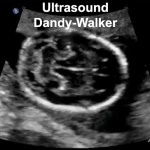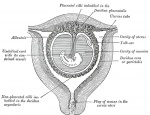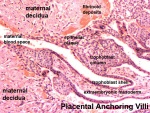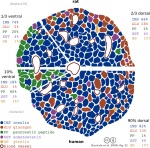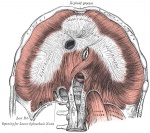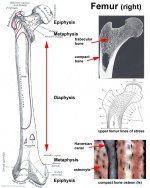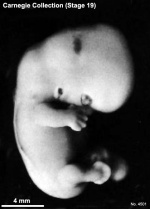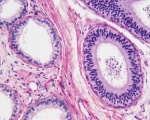D
| Embryology - 27 Apr 2024 |
|---|
| Google Translate - select your language from the list shown below (this will open a new external page) |
|
العربية | català | 中文 | 中國傳統的 | français | Deutsche | עִברִית | हिंदी | bahasa Indonesia | italiano | 日本語 | 한국어 | မြန်မာ | Pilipino | Polskie | português | ਪੰਜਾਬੀ ਦੇ | Română | русский | Español | Swahili | Svensk | ไทย | Türkçe | اردو | ייִדיש | Tiếng Việt These external translations are automated and may not be accurate. (More? About Translations) |
Glossary Links
- Glossary: A | B | C | D | E | F | G | H | I | J | K | L | M | N | O | P | Q | R | S | T | U | V | W | X | Y | Z | Numbers | Symbols | Term Link
D
Dact1
- (Dapper, Antagonist of Beta-Catenin 1) An intracellular protein that binds the membrane protein Vangl2, expressed at the primitive streak epithelial–mesenchymal transition region. Mutations of this gene in mouse (Frodo mouse or Dapper Xenopus) mimic human malformations in the spine, genitourinary system and distal digestive tract.
- (More? Molecular Development | OMIM Dapper)
dactyly
- (Greek, daktulos = finger or digit) used as a siffix with words describing limb abnormalities associated with either fingers on the hand or toes on the foot. For example, polydactyly is an abnormality resulting in additional fingers or toes.
- (More? Limb Abnormalities)
dally-like
- (Dlp) A heparan sulfate proteoglycan (HSPG) protein found in Drosophila that is required for inhibition of the hedgehog (Hh) signaling pathway. A member of the glypican family of consists of six unique polypeptides in mammals and is characterized by an N-terminal globular domain with 14 conserved cysteine residues.
- (More? Fly Development | PMID 20231458)
damaged DNA-binding protein
- (DDB) two proteins (DDB1 and DDB2) that form a complex which recognizes ultraviolet-damaged (UV) DNA and begins repair process (nucleotide excision repair, NER). This complex has been shown to be required for (mouse) epidemis and hair follicle development.
- (More? Integumentary System Development | Molecular Development | OMIM - DDB1 DDB2 | PMID 17301228)
Dandy-Walker malformation
- (DWM, Dandy-Walker Syndrome) The most common cerebellum development malformation in humans. Recently found to be associated with FOXC1, which leads to cerebellar vermis hypoplasia (CVH) and also affects eye development and glaucoma. Named after Walter Dandy (1886 – 1946) and Arthur Earl Walker (1907 – 1995), two USA neurosurgeons.
DAX1
- Acronym for "D"osage sensitive sex reversal (DSS), "A"drenal hypoplasia congenita (AHC) critical region on the "X" chromosome, gene "1" , (gene NR0B1) is a nuclear hormone receptor involved in female ovary development.
- (More? Ovary Development | genital | OMIM Entry DAX1)
DAZL
- Acronym for DAZ-like due to homology to DAZ (Deleted in AZoospermia), a gene on the long arm of the Y chromosome that is frequently deleted in infertile men with nonobstructive azoospermia.
- (More? spermatozoa | OMIM Entry DAZL)
Deaf-1
- Acronym for "D"eformed "e"pidermal "a"utoregulatory "f"actor-"1", a transcription factor that regulates epithelial cell proliferation and side-branching in mammary gland development. A small Rho-like GTPase (Rac3) has been identified as a potential target of Deaf-1 in mouse mammary epithelial cells. Also expressed in central nervous system, dorsal root ganglia, submandibular gland, epidermis and embryo mammary placodes.
- (More? Integumentary System - Mammary Gland Development | OMIM Entry Deaf-1 | PMID 18826651)
DDB
- Acronym for damaged DNA-binding protein complex. This complex, consisting of two proteins DDB1 and DDB2, recognizes ultraviolet-damaged (UV) DNA and begins repair process (nucleotide excision repair, NER). Required for (mouse) epidemis and hair follicle development.
decidua
- (Latin, decidua = a falling off) The term given to the uterine endometrium following implantation and signaling which transforms the uterine stromal cells (fibroblast-like). The uterine change commences at the site of implantation, forming the decidua basalts (placentalis) and spreads through the remainder of the uterus forming the decidua parietalis (decidua vera). The overlying uterine lining at the site of implantation forms the decidua capsularis (reflecta).
- (More? Maternal Decidua | Placenta Development | Week 2 | menstrual cycle | Uterus Development)
decidua basalis
- (placentalis) The term given to the uterine endometrium at the site of implantation where signaling transforms the uterine stromal cells (fibroblast-like) into decidual cells. This forms the maternal component of the placenta, the decidualization process gradually spreads through the remainder of the uterus, forming the decidua parietalis.
- (More? Maternal Decidua | Placenta Development | Week 2)
decidua basalis reaction
- Term describing the maternal endometrial changes that occur initially at the site of, and following, blastocyst implantation. Seen as a deposition of glycogen, fibrin, proliferation of blood vessels and conversion of stromal cells. See also decidualization.
- (More? Maternal Decidua | Placenta Development | Week 2)
decidua capsularis
- (decide reflecta) The term given to the uterine endometrium which has been converted to decidua surrounding the conceptus on the smooth chorion side.
- (More? Maternal Decidua | Placenta Development | Week 2)
decidua parietalis
- (decidua vera) The term given to the remainder of the uterine endometrium, away from the site of implantation, that gradually becomes converted to decidua.
- (More? Maternal Decidua | Placenta Development | Week 2)
decidua vera
- (decidua parietalis) Historic terminology for the decidua parietalis.
- (More? Maternal Decidua | Placenta Development | Week 2)
decidual cell
- The uterine stromal cells (fibroblast-like) that differentiate in response to both steroid hormones (progesterone) and embryonic signals. These cells then alter uterine environment to support further embryonic development as well as producing cytokines related to prolactin (PRL) and have an innate immune function.
decidual natural killer
- (dNK) Maternal immune cell, a subset of the natural killer cells (NK), may regulate implantation through interaction with fetal trophoblast cells. These cells form about 70% of the decidual immune cell population and secrete soluble factors (cytokines, growth factors and pro-and anti-angiogenic proteins).
- (More? Implantation | Trophoblast | Placenta Development | Week 2)
Declaration of Helsinki
- Declaration of Helsinki was developed by The World Medical Association (WMA) as a statement of ethical principles for medical research involving human subjects, including research on identifiable human material and data. The Declaration is intended to be read as a whole and each of its constituent paragraphs should not be applied without consideration of all other relevant paragraphs. It is widely regarded as the cornerstone document on human research ethics. It is named after the location of its initial adoption in Helsinki, Finland, in June 1964.
decidualization
- (decidualisation) The process by which uterine stromal cells differentiate in response to both steroid hormones and embryonic signals into large epitheliod decidual cells. This process is essential for the progress of implantation and establishing fetal-maternal communication.
- (More? Maternal Decidua | Placenta Development | Week 2)
decreased fetal movements
- (DFM). Decreased fetal movements can occur during the normal fetal period. Pregnancies with multiple occasions of decreased fetal movements are at increased risk of poor perinatal outcomes, including fetal death, intrauterine fetal growth restriction (IUFGR) or preterm birth. An evaluation of women presenting with DFM should involve a thorough history, examination and auscultation of fetal heart, cardiotocography (CTG) and ultrasound if indicated.
- (More? Fetal Development | Stillbirth and Perinatal Death | Ultrasound | RANZCOG Guideline 2013 PDF | Health 2011 | PMID 25393464 PMID 24007565)
DFM
- Acronym for Decreased Fetal Movements.
- (More? Fetal Development | PMID 25393464)
deiodinase
- A group of enzymes that can modify the thyroid prohormone secreted by the thyroid gland either activating (deiodinase 2) or deactivating (deiodinase 3) thyroid hormone. Their role is thought to regulate the amount of active hormone available locally in a tissue.
- (More? Thyroid Development)
deiodinase 2
- (Dio2) A deiodinating enzyme that activates thyroid hormone by clipping the 5'-iodine off of the T4 prohormone to create T3, which is the preferred ligand for thyroid receptors. The enzyme has 5'- outer ring (5'-) catalytic activity. Has a role in regulating the amount of active hormone available locally in a tissue.
- (More? Thyroid Development)
deiodinase 3
- (Dio3) A deiodinating enzyme that inactivates thyroid hormone by removing the 5-iodine from either the T4 prohormone or the T3 active hormone. The enzyme has 5- inner ring (5-) catalytic activity. Has a role in regulating the amount of active hormone available locally in a tissue.
- (More? Thyroid Development)
delayed puberty
- (Latin, pubertas = adulthood) An abnormal timing of puberty. Determined in boys by a lack of increase in testicular volume by the age of 14 years. In girls, no breast development by the age of 13.5 years and a lack of menstruation by the age of 16 years. There can also be a "pubertal arrest" where there is no progress in puberty over 2 year period.
- (More? Puberty Development | genital | Ovary Development | menstrual cycle)
delta cell
- Cells located within pancreas endocrine islets that secretes somatostatin.
- (More? Endocrine - Pancreas Development | Endocrine System Development | Gastrointestinal Tract Development)
Delta-like ligand
- (Dll) one of two (Delta and Serrate family) plasma membrane (transmembrane) ligands for the Notch family of receptors. Vasular endothelial growth factor (VEGF) induces one form (Dll4) to acting in negative feedback regulatoion to prevent excessive blood vessel formation
Delta-like ligand (Dll) 4
- Delta-like ligand (Dll) 4, a transmembrane ligand for the Notch family of receptors, ... Dll4 is induced by VEGF as a negative feedback regulator and acts to prevent overexuberant angiogenic sprouting
dendritic cell
- (DC, antigen-presenting cell, APC) A key cell in the adaptive immune pathway. These cells present antigens and induce a primary immune response in resting naïve T lymphocytes. In 2011 Ralph M. Steinman received half the Nobel Prize half of the award to to Ralph M. Steinman for his discovery of the dendritic cell and its role in adaptive immunity.
- (More? Immune System Development | 2011 Nobel Prize)
dendrite
- A thin cellular process found in neurons that bring signals towards the neuron's cell body (soma).
- (More? neural)
Denonvilliers fascia
- (DF) Anatomical structure, a fascia between the mesorectum and prostate (or vagina) in adults. Developmentally thought to be a remnant of the peritoneum. Alternately suggested (PMID 25008480), in the later stages of fetal development formed from mechanical stress on the increased volumes of the mesorectum, seminal vesicle, prostate and vagina and/or enlarged rectum.
- (More? PMID 25008480)
dentin
- The bone-like material in body of tooth, lacks osteocytes.
dentin phosphophoryn
- (DPP) is part of dentin sialophosphoprotein (DSPP) synthesized in both mesenchyme and epithelium, involved in two developmental processes: epithelial-mesenchymal interactions and branching morphogenesis.
dermatoglyphic
- The line patterns (ridges) on the skin found on the palms of the hands (finger and palm prints) and soles of the feet.
- (More? Integumentary Development)
dermatome
- The early embryonic dorsal portion of the somite that will contribute the dermis and hypodermis of the skin. Note in the adult, this term is used to the skin sensory region innervated by a single spinal (nerve) segment.
- Development: mesoderm - paraxial mesoderm - somite - dermomyotome - dermatome - dermis
- (More? Somitogenesis | Musculoskeletal System Development | Integumentary System Development | neural)
dermomyotome
- Early embryonic dorsolateral half of the somite that will later divide to form both the dermatome and myotome. The dermatome will contribute the dermis and hypodermis of the skin. The myotome will contribute the skeletal muscle of muscoloskeletal system.
- Development sequence: mesoderm to paraxial mesoderm to somite to "dermomyotome" then dermatome and myotome
DES
- Diethyl stilbestrol or diethylstilbetrol, a drug prescribed to women from 1938-1971 to prevent miscarriage in high-risk pregnancies. Acts as a potent estrogen (mimics natural hormone) and therefore a potential endocrine disruptor. Female fetus, increased risk abnormal reproductive tract and cancer. Male fetus, abnormal genitalia. Banned by USA FDA in 1979 as a teratogen, previously used as livestock growth promoter.
Descemet's membrane
- Develops from corneal stroma and ectoderm, a specialized basement membrane of the endothelial cells which lies between the corneal stroma and the endothelial layer of the cornea. Named after the French physician Jean Descemet (1732-1810).
- (More? Sensory - Vision Development)
DET
- Acronym for Double-Embryo Transfers, where two embryos transferred when women undergo in vitro fertilization compared to single-embryo transfer (SET).
- (More? In Vitro Fertilization)
detrusor muscle
- The smooth muscle forming 3 layers surrounding the urinary bladder required for emptying, urination, following internal urethral orifice opening.
- (More? renal | Lecture - Renal Development)
deuterostome
- (Greek, Deuterostomia = "mouth second") Animals, consisting of four extant phyla; Chordata (chordates), Echinodermata (echinoderms), Hemichordata (hemichordates) and Xenacoelomorpha.
- (More? Taxonomy Browser | PMID 25903627)
deuteranomaly
- (red/green colourblind) The most common form (affecting 5-6 % of males) of male colour blindness that is also an X-linked disorder. This is a mild form of colour blindness, the green cone photopigment is abnormal, yellow and green appear redder and it is difficult to tell violet from blue. The other 3 forms of red/green colour blindness are deuteranopia, protanomaly and protanopia.
deuteranopia
- (red/green colourblind) Males with deuteranopia have no working green cone cells. They tend to see reds as brownish-yellow and greens as beige. Deuteranopia is an X-linked disorder that affects about 1 % of males.The other 3 forms of red/green colour blindness are deuteranomaly, protanomaly and protanopia.
developmental dysplasia of the hip
- (DHH, congenital dislocated hip, congenital hip dislocation, congenital hip dysplasia) Term describes a spectrum of musculoskeletal disorders of hip instability due either to the femoral head being able to move outside the acetabulum (luxation or dislocation), or abnormally within the acetabulum (subluxation or partial dislocation). This includes presentation following a normal examination of the hips in the newborn period (Ortolani and Barlow tests). When detected can be managed with splinting (Denis-Browne splint) allows the hip joint to develop normally and does not require surgery. If undetected and left untreated, the hip joint develops abnormally and surgical reduction is required.
developmental origins of health and disease
- (DOHAD, Barker's Hypothesis) A correlation of the measurement of birth weight (index of fetal health and intrauterine growth), and again at 1 year (index of infant growth) and their later morbidity (incidence of cardiovascular disease, hypertension, stroke, diabetes and hyperlipidaemia) and mortality.
diabetes insipidus
- The disorder is related to the hormone antidiuretic hormone (ADH, also called vasopressin) its synthesis, secretion, receptors and signaling pathway. In diabetes insipidus there is an excretion of large amounts (up to 30 litres/day) of a watery urine and an unremitting thirst.
- (More? renal)
diabetes mellitus
- A disease due to inadequate regulation of blood glucose usually by altered production of insulin by the pancreas. There are three main types of diabetes: Type 1 (Insulin-Dependent Diabetes Mellitus), Type 2 and gestational diabetes.
- (More? Endocrine - Pancreas Development | | Maternal Diabetes)
Diabetes Type 1
- (Insulin-Dependent Diabetes Mellitus (IDDM), juvenile onset diabetes) The disease is due to the pancreas not making insulin. It can occur at any age, though it usually arises in childhood or youth, hence juvenile onset diabetes. An autoimmune disease progressive destruction of the insulin-producing beta cells in the pancreatic islets. Has both a genetic and environmental component to the disease development.
- (More? Endocrine - Pancreas Development | Maternal Diabetes | Medline - Diabetes Type 1)
Diabetes Type 2
- The most common (80%) form of diabetes. The disease due to noninsulin-dependent diabetes, where body becomes resistant to insulin a life-long disease marked by high levels of sugar in the blood.
diabetic placenta
- Term describing the structural and functional changes to placenta structure associated with maternal diabetes (Type 1). Placental terminal villi show vascularity changes, including both decreased (hypovascularity) and increased (hypervascularity), altered blood vessel permeability and villi stromal structure.
- (More? Diabetic Placenta | Maternal Diabetes)
diakinesis stage
- (diakinesis phase; Greek, diakinesis = "moving through") A meiotic cell division stage seen during prophase I. Prophase I is further divided into 5 stages based upon changes associated with the synaptonemal complex structure that forms between two pairs of homologous chromosomes. In diakinesis, prophase I ends and chromosomes now recondense, transcription stops and the transition to metaphase occurs.
- Prophase I stages: leptotene - zygotene - pachytene - diplotene - diakinesis
- (More? Cell Division - Meiosis | Oocyte Development | spermatozoa | Week 1)
diamniotic
- A twinning term, where the twins have two amniotic sacs, which can occur in both early and late monozygotic twinning. In a monozygotic twinning event (one fertilised egg and a single spermatozoa, form a single zygote) which occurs early (within 2 days of fertilization) where each embryo then develops separately its own chorionic sac (placenta) and amnionic sacs (dichorionic diamniotic). Later splitting (more than 2 days after fertilization) may result in a shared placenta and only duplication of the embryonic amnionic sacs (monochorionic diamniotic twins).
- (More? Twinning)
diaphragm
- A general term for a membranous sheet. In anatomy, describes the muscular sheet separating chest from abdomen with several different embryonic origins. Regular contraction of the diaphragm is required in respiration. The diaphragm forms initially at the lower end of the pleuroperitoneal canal.
- Embryonic origins: transverse septum (septum transversum) - tendon of the diaphragm, 3rd to 5th somite pairs - musculature of diaphragm, ventral pleural sac - connective tissue, mesentry of oesophagus - connective tissue around oesophasus and inferior vena cava, and pleuroperitoneal membranes - connective tissue around central tendon.
diaphysis
- An anatomical bone term describing the shaft of long bones.
diastema
- A toothless region found in mice between the incisor and the first molar. Thought to result from murine evolutionary loss of incisor, canine, and premolars.
- (More? Mouse Development)
Dicer
- A small (21 nucleotide) regulatory RNA required in RNA interference and small temporal RNA (stRNA) pathways to produce the active small RNA component that represses gene expression. An endonuclease that cleaves precursor microRNAs (miRNAs) into mature miRNAs during miRNA biogenesis.
- (More? Cartilage Development | Molecular Development | OMIM - DICER | PMID 17981704)
dichorionic
- A twinning term, in a monozygotic twinning event (one fertilised egg and a single spermatazoa, form a single zygote) which occurs early (within 2 days of fertilization) where each embryo then develops separately its own chorionic sac (placenta) and amnionic sacs (dichorionic diamniotic). Later splitting (more than 2 days after fertilization) may result in a shared placenta and only duplication of the embryonic amnionic sacs (monochorionic diamniotic twins).
- (More? Twinning)
DICOM
- (ISO standard 12052:2006) Acronym for Digital Imaging and Communications in Medicine, a clinical standard for handling, storing, printing, and transmitting imaging information. Clinical imaging formats include: Computed Tomography (CT),Template:Magnetic Resonance Imaging (MRI), Ultrasound, X-Ray, Fluoroscopy, Angiography, Mammography, Breast Tomosynthesis, Positron Emission Tomography (PET), Single Photon Emission Computed Tomography (SPECT), Endoscopy, Microscopy, Whole Slide Imaging, Optical Coherence Tomography (OCT). The National Electrical Manufacturers Association (NEMA) holds the copyright for this standard.
- (More? Ultrasound | NEMA DICOM)
dictyate
- A term used to describe the stage at which oocytes in the ovary are arrested in meiosis, this stage can vary between species. In human, the prenatal arrest occurs in the late prophase diplotene stage.
- (More? image - meiosis and oogenesis | Oocyte Development | Meiosis)
dielectrophoresis
- (DEP) Term describing the response of the induced dipole moments of particles due to the application of an external non-uniform electric field. This technique has been suggested as an alternative assay, to morphologic parameters, to select animal embryos for transfer. In the mouse preimplantation selection the embryo's light-induced dielectrophoresis response was found to be highly correlated with its developmental stage.
- (More? In Vitro Fertilization | mouse | PMID 20405021)
diencephalon
- (encephalon = brain) the embryonic neural tube region that will form the thalmus, hypothalmus and other nuclei in the adult brain. The diencephalon is the second most anterior of the 5 secondary brain vesicles formed from division of the prosencephalon (forebrain) primary brain vesicle (there are 3 primary brain vesicles). It is at the level of the diencephalon that the optic stalks (optic nerve) extends from the brain. The diencephalon lumen (cavity of the neural tube) will form the third ventricles.
- Secondary brain vesicles: telencephalon - diencephalon - mesencephalon - metencephalon - myelencephalon
- (More? neural | Ventricular Development)
diestrus
- In most female mammals, the last stage in the estrous cycle immediately before the next cycle proestrus characterized by a functional corpus luteum and an increase in the blood concentration of prosgesterone.
- (More? Estrous Cycle | Mouse Estrous Cycle)
differentiation
- The process of development of specific cell types from stem or precursor cells by gene activation and repression.
diffusion
- (Latin, diffundere = "to pour out") Random movements that lead to a uniform distribution of molecules both within a solution and on the two sides of a membrane.
diffusion tensor imaging
- (DTI) A newly developed form of magnetic resonance imaging (MRI). Magnetic field variations of the MRI magnet are applied in at least six different directions generating a three dimensional shape of the diffusion pattern. This technique can be used in neural imaging of white matter due to the orientation of axon bundles and the associated water flow.
DiGeorge syndrome
- (velocardiofacial syndrome) DiGeorge syndrome is the most frequent microdeletion syndrome in humans caused by a hemizygous deletion (1.5 to 3.0-Mb) of chromosome 22q11.2 with cardiovascular, thymic and parathyroid, craniofacial anomalies, renal anomalies, hypocalcemia and immunodeficiency.
- (More? Thymus Development | OMIM - Digeorge Syndrome | PMID 17041894)
digital ray
- Limb development term used to describe the first indication of digits (fingers and toes) that appear on the "paddles" of the upper and lower lower limbs. In humans, these digital rays appear during week 6 of embryonic development and occur in the upper limb before the lower limb. They appear as cells in the region between the future digits die by apoptosis.
digit
- Anatomical term for either the finger or toe. In humans, appear first as digital rays during week 6 of embryonic development. Digit formation also begins in the upper limb before the lower limb.
- (More? Limb Development)
dihydrotestosterone
- The hormonally active form of testosterone (male sex hormone) produced by enzyme (5-alpha reductase) conversion. In the male embryo, this can occur in the genital skin which then supports external genital development. In the adult, this conversion occurs in a number of different tissues. A known treatment for prostate cancer include 5-alpha reductase inhibitors.
dilate and curettage
- (D and C, D&C) A clinical gynecological term referring to the medical procedure involves opening of the cervix (dilate) and scraping away of the uterus lining or endometrium using a tool, the curette (curettage). This material can then be examined.
- (More? menstrual cycle)
diminished ovarian reserve
- Clinical ART term for a diagnosis that means that the ability of the ovary to produce eggs is reduced due to congenital, medical, or surgical causes or advanced age.
- (More? In Vitro Fertilization)
dioscorea bulbifera
- A plant, the "air potato" which contains the steroid diosgenin used historically for progesterone synthesis.
- (More? menstrual cycle)
diploid
- (Greek, di = double + ploion = vessel) Having two sets of chromosomes, the normal state for all cells other than the animal gametes that are haploid (a single set of chromosomes).
- (More? Mitosis | Fertilization | Week 1)
diplotene phase
- (diplotene stage) See entry diplotene stage.
diplotene stage
- (diplotene phase, diplonema; Greek, diplonema = "two threads") A meiotic cell division stage seen during prophase I. Prophase I is further divided into 5 stages based upon changes associated with the synaptonemal complex structure that forms between two pairs of homologous chromosomes. In diplotene, this degrades and the chromosomes separate from one another a small amount giving this appearance. It is possible that some chromosome uncoiling may also occur allowing some gene transcription. In the developing human ovary, oocytes remain at the diplotene stage from fetal life through postnatal childhood, until puberty when the lutenizing hormone (LH) surges stimulate the resumption of meiosis.
- Prophase I stages: leptotene - zygotene - pachytene - diplotene - diakinesis
- (More? Cell Division - Meiosis | Oocyte Development | spermatozoa | Week 1 | MBoC)
direct antiglobulin test
(direct Coombs' test) A clinical test is used to detect antibodies or complement proteins that are bound to the surface of red blood cells (RBCs). From a blood sample, RBCs are washed (removing the patient's own plasma) and then incubated with antihuman globulin (Coombs' reagent). If this produces agglutination of RBCs, the direct Coombs' test is positive, a visual indication that antibodies (and/or complement proteins) are bound to the surface of red blood cells.
discus proligerus
- (cumulus oophorus) Historic term for the cumulus oophorus, the granulosa cells that form a column of cells that attaches the oocyte to the antral follicle wall.
disomy
- Genetic term referring to the presence of two chromosomes of a homologous pair in a cell, as in diploid. See chromosomal number genetic disorders uniparental disomy and aneuploidy. Humans have pairs usually formed by one chromosome from each parent.
Disorder of Sex Development
- (DSD) A new terminology to describe disorders of sex development. The previous human sex development terminology (intersex, true hermaphrodites, male pseudohermaphrodites and female pseudohermaphrodites) are considered outdated and stigmatising and have been replaced with the general term "Disorders of Sex Development" (DSD) established by the Consensus statement on management of intersex disorders. International Consensus Conference on Intersex. International Consensus Conference on Intersex organized by the Lawson Wilkins Pediatric Endocrine Society and the European Society for Paediatric Endocrinology. PMID 16882788 | Pediatrics
- (More? genital abnormalities)
diverticulum
- (Latin, diverticulum = by-road) blind tubular process, also used to describe a sac or pouch in organ or seen in the colon. Occurs often in development when a new structure is forming from a epithelia or tract branch or in the initial/early stages of an epitheilal-mesenchymal interaction. The plural term is diverticula. Can also be found in normal and abnormal adult anatomical structures.
dizygotic twins
- (fraternal twins, non-identical) Twins resulting from two fertilization events, involving two separate oocyte (egg, ova) and spermatozoa (sperm). The other form of twinning, monozygotic twins, results from a single fertilization event.
- (More? Abnormal Development - Twinning)
DNA
- Acronym for "D"eoxyribo"N"ucleic "A"cid. The genetic material found in mammalian chromosomes and mitochondria. Consisting of 4 nucleic acids (ATCG) that combine in a triptych (3 nucleotide) code for protein amino acids (3 nucleotides = 1 amino acid).
- (More? Molecular Development)
DNA duplex
- The double stranded base-paired "D"eoxyribo"N"ucleic "A"cid (DNA) forming a helix. This paired strand forms the basic structure of the nucleotide genetic material forming with proteins the chromosomes.
- (More? Molecular Development)
DOB
- Acronym used clinically for Date Of Birth.
- (More? Birth)
Dolly
- The name given to the first cloned sheep (1996) generated from an adult mammary gland cell. The name "Dolly" came from Dolly Parton a play on the mammary cell association.
- (More? Stem Cells)
dominant gene
- Genetic term describing the gene determining phenotype, allelic pair not determining a phenotype is therefore the recessive gene.
- (More? Molecular Development - Genetics)
dominant inheritance
- With autosomal dominant inheritance, there is an error in one of the 22 chromosome pairs. But the damaged gene dominates over the normal gene received from the other parent. If one of the parents has a disease caused by an autosomal dominant gene, all the children will have a 50 per cent risk of inheriting the dominant gene and a 50 per cent chance of not inheriting it. The children who do not inherit the damaged dominant gene will not themselves suffer from the disease, nor will they be able to pass the gene on to future children. This type of inheritance is present for example in Huntington's disease.
- (More? Molecular Development - Genetics)
donor embryo
- An embryo formed from the egg of a woman who has donated it for transfer to a woman who is unable to conceive with her own eggs (the recipient). The donor relinquishes all parental rights to any resulting offspring. (More? Week 1 Notes)
DONSON
- (DOwnstream Neighbor of SON) Gene located at 21q22.1expressed in different fetal and adult tissue (8-week fetus, 10-week fetus, fetal brain, adult brain, cerebellum, hippocampus, occipital lobe, and vermis). Mutations in DONSON have recently been shown to affect DNA duplication by disruption of replication fork stability and cause microcephalic dwarfism.
- (More? OMIM - DONSON | Nature Genetics 2017)
doppler velocimetry
- A prenatal diagnostic technique using ultrasound which can measure the flow rate of liquids through various vessels including: utero-placental vessels, fetal brain, heart, liver perfusion, and ultrasound evaluation of fetal organs. (Prenatal Diagnosis)
dormant
- (French, dormire = to sleep) Referring to a stage in the development of a seed, in which growth is suspended until restarted by environmental cues.
dorsal aorta
- (pl. dorsal aortae) In the embryo, the initially paired major embryonic blood vessels lie in the splanchnic mesoderm running the length of the embryo. These vessels extend from the pharyngeal arch arteries in the head descending to the body and lie ventral to the vertebral body. They developmentally fuse in the midline and form identifiable segmental branches as well as branches at the pelvis to the placental arteries. In the adult, it forms the descending thoracic aorta.
dorsal aortae
- Term describing the two dorsal aortas.
dorsal mesogastrium
- Gastrointestinal tract developmental structure that initially attaches the stomach to the dorsal (posterior) body wall and develops to form the greater omentum. The celiac artery is initially associated with this structure. Note the term "mesentery" in the adult refers to the region attaching the small intestine to the posterior body wall.
dorsal root ganglia
- (drg, spinal ganglia) The sensory ganglia derived from the neural crest lying laterally paired and dorsally to the spinal cord (in the embryo found ventral to the spinal cord). Connects centrally with the dorsal horn of the spinal cord.
- (More? neural crest | neural)
Down syndrome
- (trisomy 21) Common name for trisomy 21, the most common human aneuploidy where an extra copy of chromosome 21 is found in the cell genome.
- (More? Trisomy 21)
down syndrome cell adhesion molecule
- (DSCAM) Protein member of the immunoglobulin superfamily and a new class of neural cell adhesion molecules. Expressed in the developing nervous system for neuronal cell recognition in the process of self-avoidance. Potentially responsible for the Down syndrome mental retardation and visceral anomalies (Hirschsprung disease, intestinal atresia).
- (More? Trisomy 21)
doxorubicin
- (DOX, Adriamycin) Clinical anthracycline antibiotic used as an anticancer drug in the treatment of leukemias, lymphomas, lung, breast, ovary and uterine cancers. Animal model has shown that maternal administration can alter fetal thyroid-brain development axis. A rat model of maternal treatment (PMID 8801299) has also shown Oesophageal atresia (OA) and tracheooesophageal fistula (TOF)
- (More? Abnormal Development - Drugs | PMID 23183240 | PMID 8801299 )
dpc
- Acrynomn for days post coitum, used often in staging embryonic development in animal models.
DSD
- Acronym for Disorders of Sex Development.
- (More? genital abnormalities)
DTPa
- Acronym for "D"iptheria-"T"etanus-acellular "P"ertussis vaccine.
- (More? Normal Development- Immunization)
Duchenne muscular dystrophy
- (DMD) The most common X-linked skeletal muscle dystrophy occurring in boys. This cause of the disease was discovered in 1988 as a mutation in dystrophin, a protein that lies under the muscle fiber membrane and maintains the cell's integrity. As skeletal muscles have little prenatal load or use it is not until postnatally that muscle wasting occurs, usually in the anti-gravity muscles first. This is a progressive disease usually detected between 3-5 years old. Becker muscular dystrophy (BMD) is a similar disorder but allows muscles to function better than in DMD, slower progression, make a shortened form of the mutated protein.
- (More? Duchenne muscular dystrophy)
duct of Bellini
- (collecting duct) Historic anatomical term for the papillary collecting duct within the renal medullary region of the kidney.
- (More? renal)
duct of Cuvier
- (common cardinal vein) Historic anatomical term for the pair (ducts) of blood vessels that drain the anterior and posterior cardinal veins into the sinus venosus.
- (More? cardiovascular)
ductal plate
- A mesenchymal structure in the developing liver that is remodelled to generate the intrahepatic bile ducts (IHBD). Developmental abnormalities, "ductal plate malformation", arise from failure to reorganise.
- (More? liver)
ductuli efferentes
- In the testis (male gonad) series of tubular structures which arise from the rete testis and conduct spermatazoa into the ductus epididymidis. Their columnar epithelium lining consisting of both absorptive and ciliated cells (giving rise to "cogwheel appearance) which removes much of the fluid associated with the spermatazoa leaving the testes (also by the upper epididymis) thereby increasing the spermatazoa concentration.
- Spermatozoa Duct Pathway: seminiferous tubule - straight tubule - rete testis - ductuli efferentes - ductus epididymidis - ductus deferens
- (More? testis | spermatozoa | Lecture - Genital Development | genital)
ductus arteriosus
- (Botallo's duct) A prenatal vascular "shunt" which connects the left pulmonary artery and the descending aorta. Postnatal neonatal patency (patent ductus arteriosus, PDA) is a relatively common congenital cardiac anomaly occurring more frequently in premature infants.
- (More? cardiovascular)
ductus deferens
- (vas deferens, Latin, deferens = carrying-away vessel) The excretory duct of the testis that is the continuation of the canal of the epididymis. Develops from the mesonephric duct. Anatomically beginning at the lower part of the tail of the epididymis it is at first very tortuous, but gradually becoming less twisted it ascends along the posterior border of the testis and medial side of the epididymis, and, as a constituent of the spermatic cord, traverses the inguinal canal to the abdominal inguinal ring.
- Spermatozoa Duct Pathway: seminiferous tubule - straight tubule - rete testis - ductuli efferentes - ductus epididymidis - ductus deferens
- (More? testis | spermatozoa | Lecture - Genital Development | genital)
ductus epididymidis
- (epididymidis) male testes tubular structure which arise from the ductuli efferentes and conduct spermatazoa into the ductus deferens (vas deferens). The long duct is lined by a tall pseudostratified columnar epithelium.
- Spermatozoa Duct Pathway: seminiferous tubule - straight tubule - rete testis - ductuli efferentes - ductus epididymidis - ductus deferens
- (More? testis | spermatozoa | Lecture - Genital Development | genital)
ductus venosus
- The vitelline blood vessel lying within the liver that connects (shunts) the portal and umbilical veins to the inferior vena cava and also acts to protect the fetus from placental overcirculation. Absence can cause hydrops fetalis and the umbilical vein then drains directly into the inferior vena cava or right atrium. Postnatally this shunt functionally closes then structurally closes and degenerates to form it the ligamentum venosum.
- (More? Ductus Venosus | cardiovascular | Image - Stage 13 | Image - Stage 22 | Image - ductus venosus ultrasound | Image - ductus venosus pressure wave)
Duffy blood group
- Blood typing term referring to Duffy antigens that are located on a glycoprotein on erythrocytes and other cells throughout the body. Discovered in 1950 as a new blood group antibody in the serum of a multi-transfused hemophiliac patient and the reactive red-cell antigen was identified in 65% of random caucasians, and the systemic name Duffy was proposed. This was the first blood group mapped to an autosome (chromosome 1) and the glycoprotein acts as a chemokine receptor (Duffy antigen receptor for chemokines) and also in malarial infection.
- (More? Abnormal Development - Malaria | blood | PMID 20932074)
duodenum
- (Latin, duodenarius = twelve) Gastrointestinal tract forming the first region of the small intestine lying between the stomach (pyloric valve) and the jejunum. Originally named due to adult length (25 cm), which approximates to the length of 12 finger-widths.
- (More? Intestine Development | Gastrointestinal Tract Development | Lecture - Gastrointestinal Development | Image - Stage 22)
dura mater
- (Latin, dura mater = hard mother) The outer tough connective tissue meningial coat of the 3 layers that cover the central nervous system of 3 layers (overlays the arachnoid mater middle layer and pia mater inner layer). All three layers form from the meninx primitiva, a meningeal mesenchyme that is mesodermal and neural crest in origin. At the level of the skull, the outer dura layer forms the inner periosteum of the skull and the inner dura layer forms the dural folds (falx and tentorium) that contains the dural sinuses. At the level of the spinal cord, the dura is separated from the periosteum of the vertebral canal by an epidural space.
- (More? Meninges Development | Image - Meninges cartoon | neural | Axial Skeleton)
dynorphin
- Protein whos full biological function unknown, 2 possibilities. In development, neuroendocrine regulation of the developing hypothalamo-pituitary-adrenal (HPA) axis. Secondly, a potential endogenous opioid peptide which has a high affinity for the kappa-opioid receptor.
- (More? Endocrine System Development)
dysentery
- May be simply defined as diarrhoea containing blood. Although several organisms can cause dysentery, Shigella are the most important. Shigella dysenteriae type 1 (Sd1), also known as the Shiga bacillus, is the most virulent of the four serogroups of Shigella. Sd1 is the only cause of epidemic dysentery. Few studies have been done to determine how dysentery is spread, the most likely modes of transmission are person-to-person contact, and contaminated water and food.
dysbindin
- A protein that functions in some neurons for the biogenesis of lysosome-related organelles (LROs) and dopamine receptor trafficking. This protein has been also implicated in the pathogenesis of the neural disorder, schizophrenia.
- (More? PMID 19887632)
dysfunctional uterine bleeding
- (DUB) Clinical term used to describe menstrual cycle abnormal uterine bleeding in the absence of an organic disease.
- (More? menstrual cycle)
dysmenorrhoea
- A menstrual period pain which can be primary (increased sensitivity to the prostaglandins) or secondary (pathological), can be common with no associated abnormality or in association with ovarian cysts or endometriosis.
- (More? menstrual cycle)
dysraphism
- (Greek, rhaphe = suture) The clinical term often used to describe the defective fusion of the neural folds. The position and degree of failure of fusion will result in either embryonic death or a range of different neural defects. The way (mode) in which the human neural tube fuses has been a source of contention. In humans, fusion appears to initiate at multiple sites but the mode is different from that found in many animal species used in developmental studies. The defect severity dependent upon level within the tube and degree of failure (caudal failure - spina bifida, cranial failure - anancephaly)
dystocia
- (obstructed labour) Clinical term covering with normal uterine contractions an abnormal, or difficult labour and childbirth. Related in low-income countries to adverse outcome for newborns as well as maternal morbidity and mortality. Mainly associated with cephalopelvic disproportion and malpresentation or malposition. A small number can also be due to fetal hydrocephalus.
- (More? birth | Stillbirth and Perinatal Death)
Glossary Comments
Use this page to access brief definitions of specific embryology terms. Additional information can be accessed from links listed at the end of each definition. Glossary from the UNSW Embryology program compiled and written by Dr Mark Hill. Reference material used in preparing this glossary list includes: texts listed on page 1 "Reading" of each notes section, Department of Anatomy Publications, WWW resources from NCBI, NIH, OMIM, NHMRC (Australia), AMA (USA), Office of Rare Diseases (USA), PubMed Medline Dictionaries, MSDS, Merck Manual home edn. and WHO ART terminology (2009).
These notes are for Educational Purposes Only Please email Dr Mark Hill if you wish to make a comment about this current project.
Glossary Links
- Glossary: A | B | C | D | E | F | G | H | I | J | K | L | M | N | O | P | Q | R | S | T | U | V | W | X | Y | Z | Numbers | Symbols | Term Link
Cite this page: Hill, M.A. (2024, April 27) Embryology D. Retrieved from https://embryology.med.unsw.edu.au/embryology/index.php/D
- © Dr Mark Hill 2024, UNSW Embryology ISBN: 978 0 7334 2609 4 - UNSW CRICOS Provider Code No. 00098G
